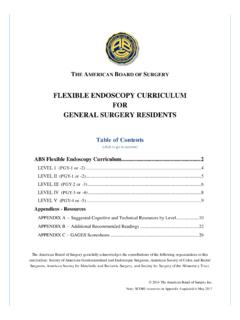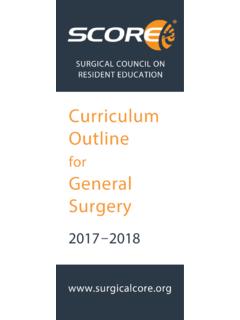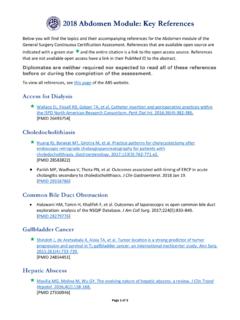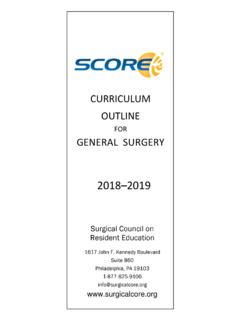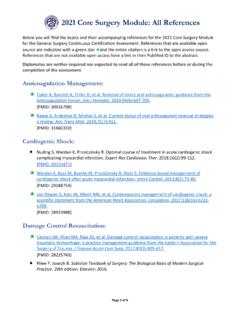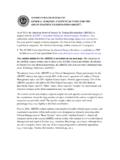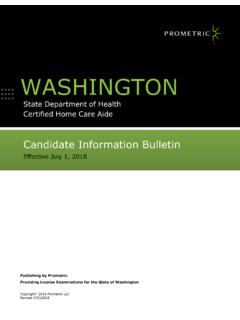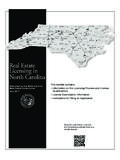Transcription of Booklet of Information - Surgery
1 TheAMERICAN BOARDof SURGERYB ooklet of InformationSurgery2016 2017 TheAMERICAN BOARDofSURGERYB ooklet of InformationSurgery2016 2017 Office of the SecretaryAmerican Board of Surgery 8601617 John F. Kennedy BoulevardPhiladelphia, PA 19103-1847 Tel. 215-568-4000 Fax Booklet of Information Surgery is published by the American Board of Surgery (ABS) to outline the requirements for certification in Surgery . Applicants are expected to be familiar with this informa-tion and bear ultimate responsibility for ensuring their training meets ABS require-ments, as well as for acting in accordance with the ABS policies governing each stage of the certification edition of the Booklet supersedes all previous publications of the ABS concern-ing its policies, procedures and require-ments for examination and certification in Surgery .
2 The ABS, however, reserves the right to make changes to its fees, policies, procedures and requirements at any are encouraged to visit the ABS website at for the most recent updates. Admission to the certification process is governed by the policies and requirements in effect at the time an application is submitted and is at the discretion of the ABS. TABLE OF CONTENTSI. INTRODUCTION ..4A. Mission ..4B. Purpose ..4C. History ..4D. Certification Process ..5E. Specialty of Surgery Defined ..5F. Website Resources ..7II. REQUIREMENTS FOR CERTIFICATION ..9A. Essentials of General Surgery ..9 B. Exam Admissibility: 7-Year Limit ..10C. General Requirements ..10D. Undergraduate Medical Education ..11E. Graduate Surgical Education ..111. General Information .
3 112. Specific Requirements ..12F. Operative Upcoming Requirements ..16H. Leave Policy ..17I. Ethics and Professionalism ..18J. Additional Considerations ..191. Military Service ..192. Foreign Graduate Education ..193. Flexible Rotations Option ..214. Re-entry to Residency Training ..215. Osteopathic Trainees ..226. Information for Program Directors ..227. Reconsideration and Appeals ..23 III. EXAMINATIONS IN Surgery ..24A. In-Training Examination ..24B. Qualifying Examination ..241. General Information ..242. Application Process ..253. Admissibility and Opportunities ..264. Taking QE After PGY-4 ..265. Readmissibility ..27C. Certifying Examination ..271. General Information ..272. Admissibility and Opportunities ..283. Readmissibility ..29D. Spe cial Circumstances.
4 291. Persons with Disabilities ..292. Examination Irregularities ..293. Substance Abuse ..30IV. ISSUANCE OF CERTIFICATES AND MOC ..31A. Reporting of Status ..31B. Maintenance of Certification (MOC) ..32C. Revocation of Certificate ..32D. Certification in Surgical Specialties ..34V. ABOUT THE ABS ..36A. Nominating Organizations ..36B. Officers and Directors .. , Component Boards and Advisory Councils .. Members, Former Officers, Executive Staff ..38(click to go to section)- 4 -I. INTRODUCTIONA. MissionThe American Board of Surgery serves the public and the specialty of Surgery by providing leadership in surgical education and practice, by promoting excellence through rigorous evaluation and exami-nation, and by promoting the highest standards for professionalism, lifelong learning, and the continu-ous certification of surgeons in PurposeThe American Board of Surgery is a private, nonprofit, autonomous organization formed for the following purposes: To conduct examinations of acceptable candidates who seek certification or maintenance of certifica-tion by the board.
5 To issue certificates to all candidates meeting the board s requirements and satisfactorily complet-ing its prescribed examinations. To improve and broaden the opportunities for the graduate education and training of ABS considers certification to be voluntary and limits its responsibilities to fulfilling the pur-poses stated above. Its principal objective is to pass judgment on the education, training and knowledge of broadly qualified and responsible surgeons and not to designate who shall or shall not perform surgical operations. It is not concerned with the attainment of special recognition in the practice of Surgery . Furthermore, it is neither the intent nor the purpose of the board to define the requirements for membership on the staff of hospitals or institutions involved in the practice or teaching of HistoryThe American Board of Surgery was organized on January 9, 1937, and formally chartered on July 19, 1937.
6 The formation of the ABS was the result of a committee created a year earlier by the American Surgical Association, along with representatives from other national and regional surgical societies, to establish a certification process and national certifying body for individual surgeons practicing in the The committee decided that the ABS should be formed of members from the represented organiza-tions and, once organized, it would establish a comprehensive certification process. These findings and recommendations were approved by the coop-erating societies, leading to the board s formation Back to TOC- 5 -in 1937. This was done to protect the public and improve the ABS was created in accordance with the Advisory Board of Medical Specialties, the accepted governing body for determining certain specialty fields of medicine as suitable for certification.
7 In 1970 it became known as the American Board of Medical Specialties (ABMS) and is currently composed of 24 member boards, including the ABS. D. The Certification ProcessThe American Board of Surgery considers certification in Surgery to be based upon a process of education, evaluation and examination. The ABS holds undergraduate and graduate education to be of the utmost importance and requires the attestation of the residency program director that an applicant has completed an appropriate educational experience and attained a sufficiently high level of knowledge, clini-cal judgment and technical skills, as well as ethical standing, to be admitted to the certification process. Individuals who believe they meet the ABS educational, professional and ethical requirements may begin the certification process by applying for admission to the Qualifying Examination (QE).
8 The application is reviewed and, if approved, the applicant is granted admission to the examination. Upon successful completion of the QE, the applicant is considered a candidate for certification and granted the opportunity to take the Certifying Examination (CE). If the candidate is also successful in passing the CE, the candidate is deemed certified in Surgery and becomes a diplomate of the ABS. Possession of a certificate is not meant to imply that a diplomate is competent in the performance of the full range of complex procedures that encompass general Surgery as defined in section I-E. It is not the intent nor the role of the ABS to designate who shall or shall not perform surgical procedures or any category thereof. Credentialing decisions are best made by locally constituted bodies and should be based on an applicant s extent of training, depth of experience, patient outcomes relative to peers, and certification Specialty of General Surgery Defined1.
9 Scope of General SurgeryGeneral Surgery is a discipline that requires knowledge of and responsibility for the preopera-tive, operative, and postoperative management of Back to TOC- 6 -patients with a broad spectrum of diseases, including those which may require nonoperative, elective, or emergency surgical treatment. The breadth and depth of this knowledge may vary by disease category. Surgical management requires skill in complex deci-sion making; general surgeons should be competent in diagnosis as well as treatment and management, including operative intervention. 2. The certified general surgeon demonstrates broad knowledge and experience in conditions affecting the: Alimentary Tract Abdomen Wall and its Contents Breast, Skin and Soft Tissue Endocrine System In addition, the certified general surgeon demon-strates broad knowledge and experience in: Surgical Critical Care Surgical Oncology Trauma3.
10 The field of general Surgery as a specialty comprises, but is not limited to, the performance of operations and procedures relevant to the areas listed above. It is expected that the certified surgeon will also have additional knowledge and experience relevant to the above areas in the following categories: Related disciplines, including anatomy, physiol-ogy, epidemiology, immunology, and pathology (including neoplasia). Clinical care domains, including wound healing; infection and antibiotic usage; fluid and electrolyte management; transfusion and disorders of coagulation; shock and resuscita-tion; metabolism and nutrition; minimally invasive and endoscopic intervention (including colonoscopy and upper endoscopy); appropriate use and interpretation of radiologic diagnostic and therapeutic imaging; and pain The certified general surgeon also is expected to have knowledge and skills for diseases requiring team-based interdisciplinary care, including related leadership competencies.
